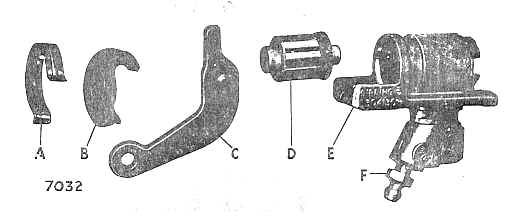WHEEL CYLINDERS
The wheel cylinder consists of an alloy body, housing a piston and seal which are protected by a rubber dust cover retained by a metal clip. The body is slotted to accommodate the toe end of the trailing shoe but the head of the piston is plain.
The wheel cylinder body adjacent to the head of the piston is built up to form a pivot for the lever of the handbrake. The longer and outer end of this lever is attached to the handbrake cable or brake rod while the short end locates an aperture in the toe end of the leading brake shoe web. The wheel cylinder is a sliding fit in the back plate thus facilitating centring of the brake shoes. The wheel cylinder is located in its slot by spring and retaining plates fitted on to the neck of the wheel cylinder body as it protrudes through the back plate. The protruding portion of the wheel cylinder body contains two tappings, which accommodate the two pressure pipes or pressure pipe and bleed screw for right hand and left hand wheel cylinders respectively.
To remove and refit (Fig. 3)
1. Remove the brake shoes from 'the back plate, see under "Brake shoes -To remove and refit".
2. Detach the handbrake cable from one cylinder lever by withdrawing the spring clip from the clevis pin, removing the plain and spring washers and withdraw- ing the clevis pin from the cable forkend or detach the |
brake rod from the opposite wheel cylinder lever by releasing the spring clip.
3. Remove the pressure pipe(s) from the wheel cylinder by releasing the union nut(s) and trapping any escaping fluid in a drip tray.
4. Remove the lever from the whee1 cylinder by easing the dust cover aside, withdrawing the retaining plate from the neck of the wheel cylinder body and manoeuvring the [ever pivot from between the wheel cylinder body and the back plate; the removal of the retaining plate will allow sufficient clearance.
5. Withdraw the wheel cylinder from the back plate by removing the spring plate and dust cover.
6. Refitting is the reverse of the removal sequence but particular attention must be given to the following:-
|
(i) Ensure that the wheel cylinder body has complete freedom of movement within the back plate slot -THIS IS IMPORTANT. |
|
(ii) Position the wheel cylinder in the back plate slot so the piston points upwards and slide the spring, open end first, from the bottom end into the groove formed in the neck of the wheel cylinder body; feed the long end of the lever through the slot in the wheel cylinder body and back plate so it points upwards and manoeuvre its pivot ,between the wheel cylinder body and back plate; fit the dust cover and retaining plate, open end first from the top end -of the groove and engage |
|
 **
**
